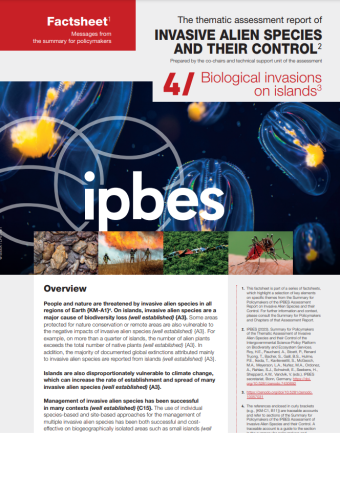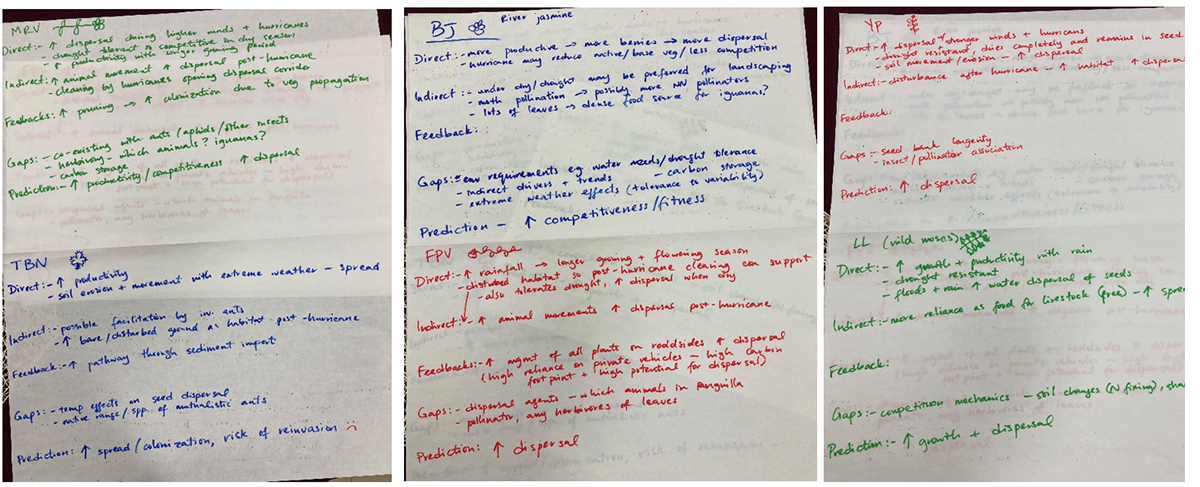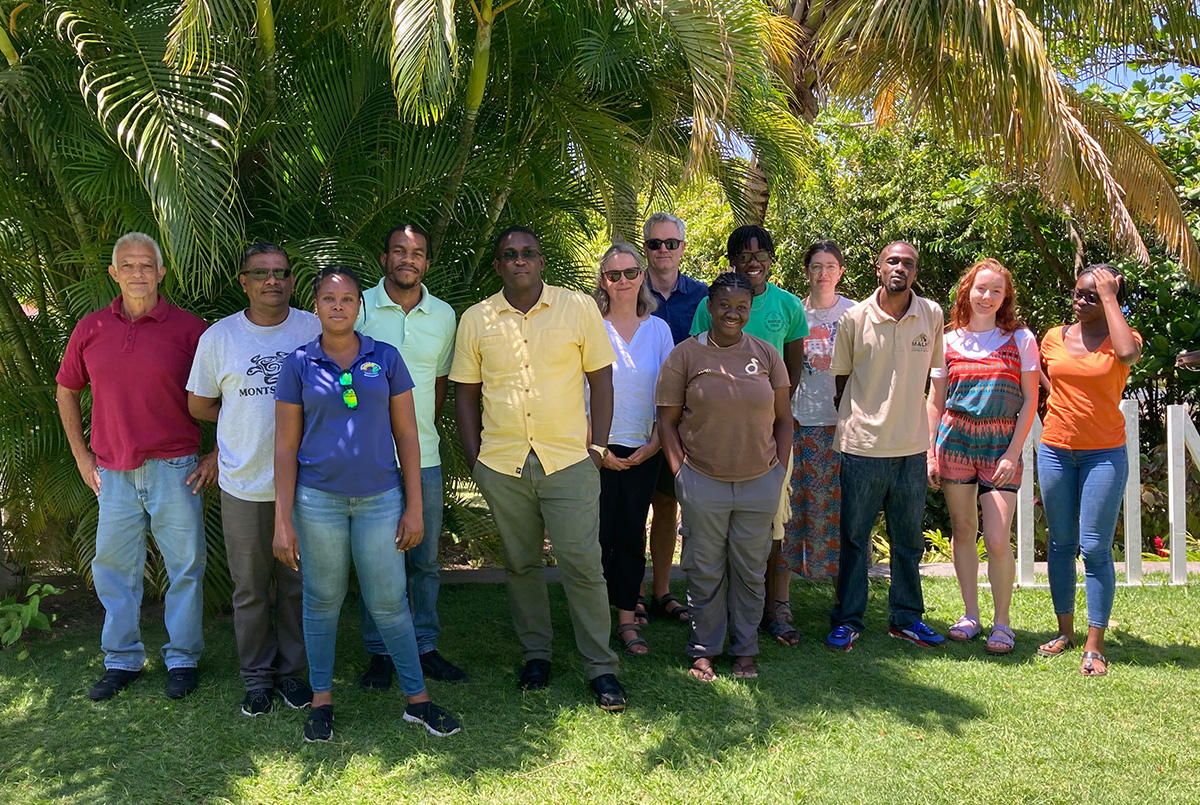Professor Helen Roy summarises collaborative work co-developing approaches for assessing the impact of invasive non-native species on the UK Overseas Territories in the context of climate change...
Categorising the magnitude of the impact of invasive non-native species is important for decision-making and prioritising action. The recently published IPBES Assessment Report on Invasive Alien Species and their Control (IPBES, 2023) highlights the major and growing threat of invasive alien species in all regions of Earth.

On islands the evidence of the impacts of invasive non-native species is particularly stark:
- 90 per cent of documented global extinctions with invasive alien species as one of the major causes, are reported from islands
- Local extinctions account for nine per cent of documented impacts of invasive alien species on islands, in contrast to four per cent on mainlands
Additionally, islands are disproportionately vulnerable to climate change, which can increase the rate of establishment and spread of many invasive alien species.
Through the Darwin Plus-funded study 'Enhancing monitoring and prevention of invasive non-native species across UKOTs', we have been working with experts on the UK Overseas Territories to develop inventories of non-native species. Over the last few years, we have discussed ways in which we can capture information on the impacts of the subset of non-native species known to have negative impacts on the unique biodiversity and ecosystems of these captivating places, which are termed invasive non-native species.
Furthermore, we have been considering how climate change might exacerbate the impacts of these invasive non-native species.
Assessing environmental and social-economic impacts of invasive non-native species
The Environmental Impact Classification for Alien Taxa (EICAT) is a global standard for measuring the severity of environmental impacts caused by invasive non-native species living outside their natural range. The structured approach provides categories and criteria that can be applied in a consistent and comparable way for different species using available evidence. The categories are:
- Minimal Concern (MC) – negligible impacts, and no reduction in performance of a native taxon’s individuals;
- Minor (MN) – performance of individuals reduced, but no decrease in population size;
- Moderate (MO) – native taxon population decline;
- Major (MR) – native taxon local extinction (i.e. change in community structure), which is naturally reversible;
- and Massive (MV) – naturally irreversible local, or global extinction of a native taxon (i.e. change in community structure).
Impacts that fall within the categories Moderate, Major or Massive are termed ‘harmful’.
When there is a lack of evidence of impact a category of Data Deficient is applied. Of course, lack of evidence of impacts does not mean there are no impacts. For many invasive non-native species there is no documented evidence of impacts on specific islands, but nevertheless local communities are only too aware of the problems they cause to biodiversity and ecosystems, and also well-being.
Reflecting on the 12 mechanisms of impact outlined in the EICAT guidance1 we explored the potential to use expert-elicitation approaches to incorporate local knowledge on St Helena, Anguilla and Montserrat within the EICAT framework. The insights and perspectives from the people living alongside these species is extensive and incredibly valuable. Indeed, the wealth of knowledge enabled us to use the EICAT framework with ease, ultimately reaching consensus on the impact classification of a diverse range of species, and also led to the identification of knowledge gaps and uncertainty.
Experts on St Helena, Anguilla and Montserrat highlighted the importance of the societal impacts of invasive non-native species including on human health and culture. The Socio-economic impact classification of alien taxa (SEICAT) follows a similar standardised method to EICAT to categorise the magnitude of impacts of invasive non-native species on human well-being by documenting changes in peoples' activities as a way of evaluating social impacts. Therefore, we were also able to apply SEICAT to the invasive non-native species that were prioritised for assessment within the workshops.
Examples of impact from St Helena, Anguilla and Montserrat
Wild mango on St Helena
Wild Mango is considered to have a broad environmental tolerance although growth is observed to be limited in drier conditions. It grows in waterways and has extensive root systems which can take up large amounts of water and so may affect water security. Wild Mango seems to have a detrimental effect on its surrounding area preventing growth of endemic plant species and the workshop participants considered this an area of possible future research.
Experts on St Helena considered that Wild Mango should be assigned the category Major for environmental impact noting that Competition was the most relevant mechanism and changes to the community are reversible through appropriate management alongside sustained and adequately resourced monitoring.
Invasive alien plants on Anguilla
An ongoing Darwin Plus project on the management of invasive non-native plants provided inspiration for which species to include in our discussions: False Puncture Vine, Rubber Vine, Tropical Bull Nettle, Yerba Porosa, Brazilian Jasmine.

Cane toads on Montserrat
Cane toads are abundant on Montserrat and the workshop participants considered the impacts on biodiversity are through Competition, Predation, Transmission of disease, Poisoning, Interaction with other alien species. The overall categorisation was considered Massive because of transmission of Chytrid to other amphibians including mountain chicken.
Capturing impact of invasive non-native species
Future management strategies on invasive non-native species can be informed by the EICAT and SEICAT classifications which will be captured within the online non-native species database that we are developing as part of this project. The standardised format in which the non-native species environmental and socio-economic impacts are categorised allows this information to be easily used by various stakeholders to inform future mitigation plans. These data also have the potential to help predict species responses to climate change scenarios and evaluate the responses of these species to extreme weather events.
Understanding the interactions between climate change and invasive non-native species
Environmental and spread models can underpin predictions about the future impacts of invasive non-native species. Species distribution models are widely used to make predictions of how species distributions may change as a response to climatic change. However, such approaches require detailed datasets of relevant climate variables and georeferenced species occurrence records. For small island nations, such information is often lacking.
Through the workshops on St Helena, Anguilla and Montserrat, we worked collaboratively to gather information on the relevant components of climate change to co-develop conceptual models for a selection of invasive non-native species. The UKOT experts described the changes that they have been noticing including increases in drought, summer temperatures and the unpredictability of seasons.
Furthermore, we considered ways in which this information could be used to make predictions on the impacts of invasive non-native species in the context of climate change. We assessed the likelihood of direct impacts of climate changes on species’ survival, reproduction, or dispersal, as well as indirect impacts mediated by changes in habitat or food resources. With few exceptions, the case studies we examined for a range of invasive non-native species led to agreement that many would be predicted to expand further due to climate change.
With few exceptions, the case studies we examined... led to agreement that many would be predicted to expand further due to climate change." Prof Helen Roy
Effects of climate change on invasive non-native mosquitos
Vector-borne diseases transmitted by invasive non-native mosquitoes can be a cause of concern even on remote islands for humans, domestic animals and wildlife. Climate change and warmer temperatures can accelerate mosquito development, the incubation period of the pathogens they carry and also affect the ecology of animal hosts and reservoirs, in favour of the mosquitoes. This in turn can increase mosquito-borne disease risks for humans and animals.
Extreme weather events such as hurricanes can also amplify mosquito populations. While adult mosquitoes will not survive the strong winds, the flooding that occurs after a hurricane can favour native floodwater mosquitoes as well as invasive alien mosquitoes such as Aedes spp. as their eggs can survive extremely harsh weather conditions.
Furthermore, it is important to understand the impacts of climate change in combination with other causes of change to mosquito populations. For example, urbanisation facilitates mosquito-borne disease transmission by enhancing mosquito breeding sites (with structures such as garden containers and drains providing pools of water), increasing the likelihood of vector–human interactions with high population densities, and increasing spread of mosquitoes through the movement of people and goods.
Raising awareness of invasive and non-native species and climate change
Sharing such information with diverse stakeholder groups is important to inform action. Experts on St Helena discussed how to use the information to raise awareness about the interactions between invasive non-native species and climate change. A short briefing note for decision-makers and other relevant stakeholders will be drafted collaboratively. In Anguilla, an opportunity was identified to develop contingency plans for invasive non-native species that might be most likely to establish and spread following hurricanes. In Montserrat, creating posters that depict a selection of invasive non-native species was considered a useful way to spread awareness, with resources for the general public and additional materials tailored specifically to farmers. It will be exciting to work together to develop these outputs during the final year of the project.
We are extremely appreciative of the warm welcome that we have received during all our visits and the excellent engagement from all participants who have shared their incredible knowledge so generously. The commitment of the local communities on the islands that we have visited is truly inspiring.

We thank Darwin Plus for providing funding and guidance throughout this research. We are extremely appreciative of the generosity of Sabrina Kumschick (Centre for Invasion Biology, Stellenbosch, South Africa) and Sven Bacher (University of Fribourg, Switzerland) who shared training materials on EICAT and SEICAT.
Professor Helen Roy
1 Competition, Predation, Hybridisation, Transmission of disease, Parasitism, Poisoning/toxicity, Bio-fouling or other direct physical disturbance, Grazing/herbivory/browsing, Chemical impact on ecosystem, Physical impact on ecosystem, Structural impact on ecosystem, Indirect impacts through interactions with other species
Related links
See more about the Darwin Plus UKOTs project
UKCEH staff page of Professor Helen Roy
